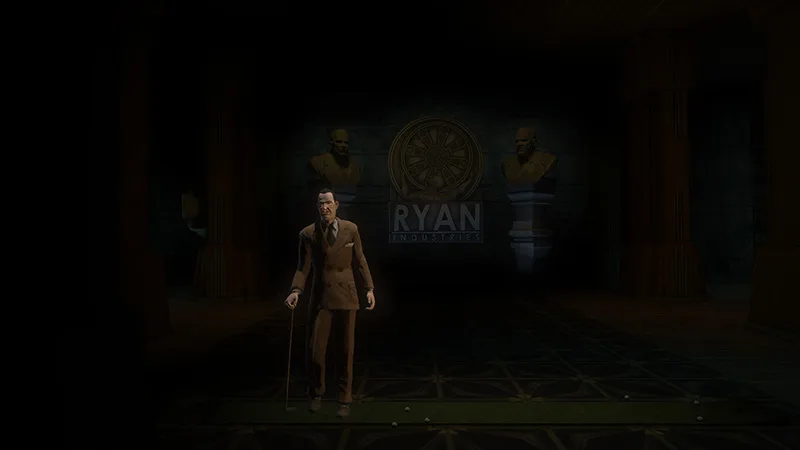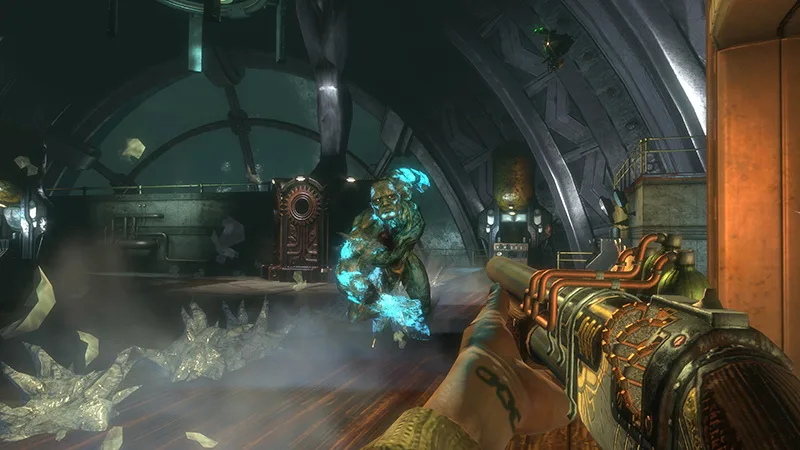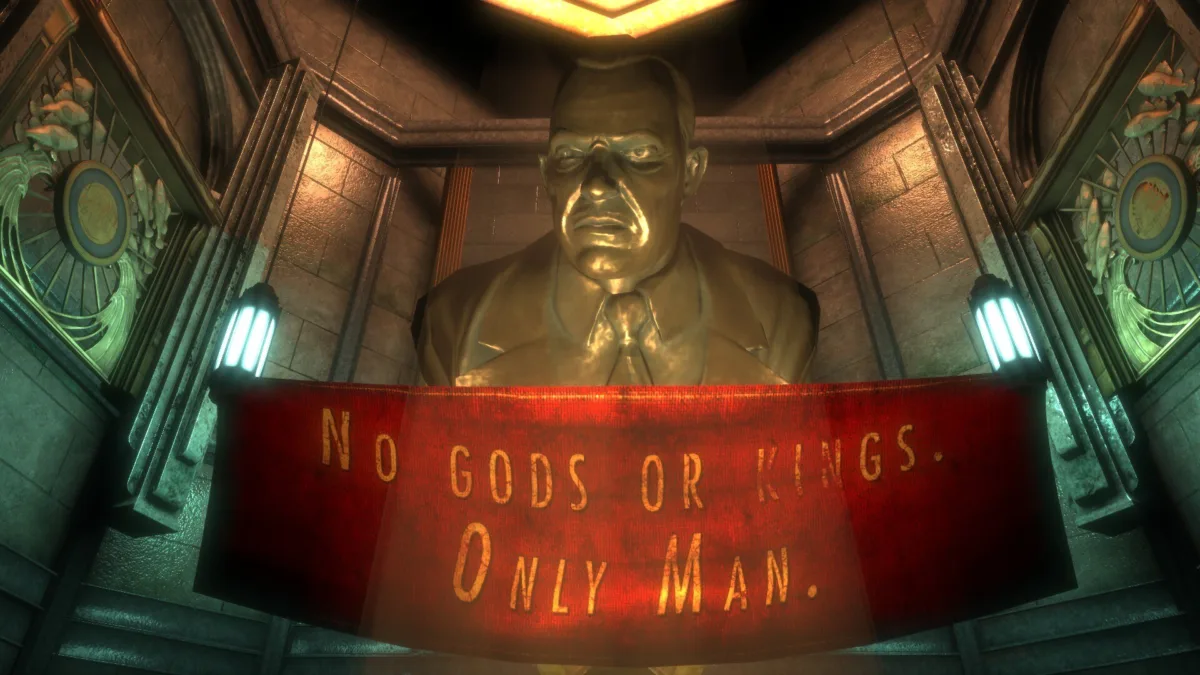This comprehensive analysis explores the complete story of BioShock (2007), the critically acclaimed video game that revolutionized narrative-driven gaming.Deep beneath the Atlantic Ocean lies a tale of ambition turned to madness. The complete Bioshock story unfolds in the underwater city of Rapture, where this critically acclaimed video game narrative revolutionized storytelling forever. Welcome to a fallen utopia where free will meets its ultimate test, and where dreams of paradise twisted into an underwater nightmare. The story of BioShock earned its place among the 18 Legendary Top Games of All Time That Transformed Culture by masterfully blending philosophical depth with atmospheric storytelling.
Table of Contents

Bioshock Story: Introduction
This section establishes the foundation of Bioshock’s world, introducing readers to the atmospheric underwater setting and the philosophical principles that drove its creation. We explore the initial descent into Rapture and the first hints of its tragic fall.
Setting the Scene: Discovering the City in Bioshock
The year is 1960. As your plane crashes into the stormy Atlantic, you find yourself swimming toward a mysterious lighthouse standing defiantly against the darkness. Inside, a bathysphere descent sequence awaits to take you to an impossible place – a city at the bottom of the ocean. This is how players first encounter Rapture, and like the protagonist Jack, they’re about to discover that the most dangerous predators aren’t always the ones with sharp teeth. As players progress through the game, they’ll encounter the iconic Big Daddy figures – formidable guardians in diving suits who protect the Little Sisters. Understanding what Big Daddies are and their role in Rapture’s ecosystem becomes crucial to survival.
As you descend through the depths, a propaganda film sequence crackles to life, introducing Andrew Ryan, the city’s founder. His voice, filled with conviction, speaks of a place where the artist wouldn’t fear the censor, where the scientist wouldn’t be bound by petty morality, where the great wouldn’t be constrained by the small. But as the bathysphere breaks through the underwater canopy, revealing Rapture’s art deco splendor, the first signs that something has gone terribly wrong become apparent.
The Rise and Fall of Rapture City
Built in 1946, Rapture was conceived as a haven for humanity’s elite minds. Ryan, disillusioned with the world’s growing embrace of collectivism, envisioned a place where individual achievement would reign supreme. The city of Rapture flourished initially, attracting artists, scientists, and entrepreneurs who shared Ryan’s dream of unfettered human progress.
Then came the discovery of ADAM. This genetic modification substance became the foundation of Rapture’s genetic revolution – a substance that could rewrite human DNA, granting extraordinary abilities to those who used it. But like all miracles, it came with a price. Genetic addiction, mutation, and madness followed in ADAM’s wake, transforming Rapture’s citizens into twisted shadows of their former selves.

Bioshock Character Analysis
To fully understand the Bioshock story explained here, we need to examine its key players. This section delves into the three central figures whose intertwined destinies shape the narrative. Through their stories, we explore how complex character development and moral ambiguity elevate Bioshock’s storytelling to new heights.
Jack: The Reluctant Hero
The Bioshock plot unfolds through Jack’s eyes, but his role is far more complex than that of a simple video game protagonist. As players guide him through the city’s decrepit art deco halls, they gradually uncover the shocking truth about his identity. Jack isn’t just another survivor – he’s a manufactured being, born and conditioned to be a weapon in Rapture’s civil war.
The revelation of the phrase “Would you kindly?” – a psychological trigger embedded in Jack’s psyche to ensure his obedience – serves as one of gaming’s most powerful narrative moments. It forces players to question every action they’ve taken, blurring the line between character agency and manipulation. Jack’s story becomes a meditation on free will in interactive entertainment, asking whether true choice can exist in a medium where players follow predetermined paths.
Andrew Ryan: The Visionary Gone Mad
Andrew Ryan stands as one of gaming’s most complex antagonists. A man who fled the Soviet Union’s collectivism, then witnessed the atomic devastation of Hiroshima, Ryan built Rapture as a testament to individual achievement. His philosophy, heavily influenced by Ayn Rand’s objectivism, promised a paradise of merit. But as city of Rapture began to crack under the weight of its contradictions, Andrew Ryan’s ideals twisted into philosophical tyranny.
The moment when players finally confront Ryan remains one of gaming’s most powerful story sequences. Rather than fight, he chooses to die by his principles, commanding Jack to kill him while exposing the truth of Jack’s conditioning. “A man chooses, a slave obeys,” he declares, turning his death into a final lesson about free will and social control.
Frank Fontaine: The Master Manipulator
If Ryan represents the corruption of idealistic philosophy, Fontaine embodies pure opportunism. The Bioshock character Frank Fontaine masterfully manipulates both Jack and the player throughout the game. His rise from small-time smuggler to Ryan’s greatest rival demonstrates how Rapture’s unrestrained capitalistic system created the perfect environment for criminal enterprise.
Fontaine’s genius lies in his ability to exploit not just Rapture’s economic system, but its philosophical contradictions. He turns Ryan’s own beliefs against him, using the free market principles to build a power base, then exploiting the poor and desperate to create an army. His final transformation, both physical and metaphorical, serves as a grotesque parody of Rapture’s promise of self-improvement through genetic modification.

Understanding Bioshock: Core Themes & Messages
In this section, we examine the deep philosophical underpinnings of Bioshock’s narrative, exploring how the game weaves complex moral decisions and political philosophy into its storytelling structure. The analysis reveals how player choice mechanics serve both gameplay and thematic purposes.
Choice and Consequence: The Player’s Dilemma
At the heart of the Bioshock narrative lies the Little Sister moral choice system – save the transformed children or harvest them for power. This choice system does more than affect the game’s ending; it challenges players to weigh immediate gameplay advantages against moral consequences. The genius lies in making both options viable, forcing players to confront their own value systems in interactive entertainment.
Players must also learn how to kill a Big Daddy – a strategic challenge that tests both combat skills and tactical planning. These encounters serve as pivotal moments that shape both the gameplay experience and moral narrative.
The Bioshock story’s exploration of choice extends beyond these specific moments to question the nature of video game agency itself. When Jack’s conditioning is revealed, every previous action is cast in a new light. The game asks: can true choice exist in a medium built on following instructions? The answer lies not in the decisions themselves, but in how we react when we discover our choices may not be our own.
Objectivism vs. Collectivism: Ideologies in Conflict
Rapture serves as both critique and cautionary tale about the dangers of ideological extremism in society. Ryan’s objectivist underwater utopia, free from government oversight or moral constraint, ultimately produces its own form of tyranny. Yet the game doesn’t simply condemn Ryan’s philosophy – it shows how even noble philosophical ideals can become corrupted when pushed to their limits.
The city’s class divide, exacerbated by the ADAM-based economy, demonstrates how unrestrained market capitalism can create the very conditions for collectivist revolution that Ryan feared. Through audio diary storytelling and environmental narrative design, we see how Rapture’s promise of unlimited opportunity gradually gave way to exploitation and rebellion.

Gameplay Mechanics and Storytelling
This section analyzes how Bioshock seamlessly integrates its gameplay systems with narrative elements. We explore how the game’s mechanical design choices reinforce its themes and enhance the player’s immersion in Rapture’s world.
Immersive Environment: A Living Narrative
Rapture itself is perhaps Bioshock’s greatest storytelling achievement in gaming. Every leaked pipe and broken window speaks to the city’s decline. Art deco architectural design clashes with makeshift barricades, while neon signs still promise luxury amid decay. Rapture’s environment doesn’t just complement the Bioshock lore – it is the narrative.
Built using Unreal Engine technology, BioShock’s successor BioShock Infinite would later push environmental storytelling even further. The game remains a testament to Unreal Engine’s capabilities in creating atmospheric worlds that tell stories through every detail.
Unreal Engine Games: Best 17 UE4 and UE5 Games
Discover 17 Best Unreal Engine games that will blow you away! Explore stunning visuals and dive deeper into the future of game development.
The game’s unique combination of plasmid combat mechanics and conventional weapons mirrors Rapture’s hybrid nature: part science, part savagery. Players experience the same temptations as Rapture’s citizens, constantly pushed to modify themselves for power while witnessing the consequences of unchecked genetic enhancement in the city’s mutated inhabitants.
The Use of Audio Diaries: Understanding Bioshock Storyline
Through scattered environmental storytelling devices, players piece together Rapture’s fall from multiple perspectives. We hear from titans of industry, humble maintenance workers, and everyone in between. These audio diary recordings do more than fill in plot gaps – they create a rich tapestry of lives caught in Rapture’s downward spiral.
The diaries reveal personal narratives of tragedy behind the city’s collapse: scientists wrestling with ethical dilemmas in research, parents desperate to protect their children, artists driven mad by unlimited freedom. Each recording adds layers to our understanding, making Rapture’s tragedy more intimate and profound.

Cultural Impact and Legacy of Bioshock
Here we examine Bioshock’s lasting influence on the video game industry and its player community, exploring how it redefined storytelling standards in interactive entertainment and sparked ongoing discussions about games as an art form.
Influence on the Gaming Industry
Bioshock’s impact on video game narrative design cannot be overstated. It proved that games could tackle complex philosophical themes while maintaining commercial success. Its approach to environmental storytelling techniques and moral choice systems influenced countless subsequent titles, while its twist ending forced developers to reconsider how they approach player agency in gaming.
The game’s success helped legitimize video games as artistic expression, capable of meaningful social commentary. It demonstrated that the medium could handle sophisticated narrative themes without sacrificing entertainment value, paving the way for more ambitious narrative projects in gaming.
Fandom and Community: The Ongoing Debate
Years after its release, Bioshock continues to spark community discussion and analysis. Players still analyze its themes, discover new details, and argue about its messages. The game’s ambiguous narrative elements – from the true nature of Rapture’s civil war to the meaning of its different endings – keep the community engaged in ongoing interpretation.
Bioshock’s immersive world and thought-provoking narrative earned it a place among the most influential games in history. Explore my list of 18 Legendary Top Games of All Time That Transformed Culture to discover other groundbreaking titles.
18 Legendary Top Games of All Time That Transformed Culture
Explore top games of all time that transformed culture, shaped societies, and redefined entertainment, from arcade classics to modern masterpieces.

The Complete Bioshock Story: Final Thoughts
My analysis concludes by reflecting on Bioshock’s enduring relevance and its position as a milestone in interactive entertainment history, while considering its lessons for modern game design and society at large.
The Enduring Story of Bioshock
Bioshock remains a masterpiece of interactive storytelling, its depths still yielding new insights years after release. Like Rapture itself, the game’s surface beauty conceals layers of complexity beneath. Its exploration of free will in gaming, ideology, and human nature continues to resonate with new generations of players.
Final Thoughts: What Does Bioshock Mean to Us?
In an era of increasing technological power and ideological division, Bioshock’s warnings about the dangers of extremism in society and unchecked technological progress remain relevant. The game asks us to consider not just what we can achieve, but what we should achieve. As we face our own questions about genetic modification ethics, artificial intelligence, and the role of government, Rapture’s cautionary tale takes on new significance.
Would you kindly remember that behind every utopian promise lies the potential for dystopian reality? In Bioshock’s world, as in our own, the most important choices are not about power, but about how we use it. The true genius of the game lies not in its twists or its technology, but in how it holds up a dark mirror to our own dreams of paradise.
The Story of Bioshock: FAQ
What is the complete Bioshock story explained simply?
Bioshock takes place in 1960 in Rapture, an underwater city built by business magnate Andrew Ryan. The story follows Jack, the main character in Bioshock, who discovers this hidden metropolis after a plane crash. The city was intended as a utopia for society’s elite minds to pursue progress without governmental or moral restrictions. However, the discovery of ADAM, a genetic modification substance, led to the city’s downfall through addiction, civil war, and societal collapse. The player must navigate this fallen paradise while uncovering the truth about their own identity and making moral choices that affect the game’s outcome.
Why is the phrase “Would you kindly?” significant in Bioshock?
“Would you kindly?” serves as a pivotal plot device and one of gaming’s most memorable twists. This phrase is revealed to be a psychological trigger implanted in the protagonist Jack‘s mind, forcing him to obey any command preceded by these words. This revelation forces players to question their agency throughout the game and serves as a meta-commentary on the nature of choice in video games, where players typically follow prescribed objectives without questioning why.
What role do Little Sisters play in the game’s narrative?
Little Sisters are genetically modified young girls who harvest ADAM from corpses throughout Rapture. They represent one of the game’s central moral choices, as players must decide whether to “harvest” them for maximum ADAM gain (killing them in the process) or “save” them for a smaller reward. These choices affect not only the player’s resources but also the game’s ending and overall themes about morality and sacrifice in desperate circumstances.
How does Bioshock critique Ayn Rand’s philosophy of Objectivism?
Bioshock serves as a critical examination of Objectivism through its portrayal of Andrew Ryan‘s failed utopia. Ryan’s ideology, directly inspired by Rand’s philosophy, emphasizes individual achievement and unregulated progress. However, the game shows how this extreme individualism ultimately leads to social collapse, with Rapture’s unrestrained capitalism creating severe inequality and its lack of ethical constraints enabling dangerous scientific experiments. The city’s fate suggests that pure Objectivism, when taken to its logical conclusion, contains the seeds of its own destruction.
What makes Rapture such a memorable gaming environment?
Rapture stands out for its unique art deco architecture and atmospheric underwater setting, but more importantly for its role as a character itself. The city tells its story through environmental details, from propaganda posters to leaked pipes, creating a richly detailed world that communicates narrative through exploration. The contrast between Rapture’s grand vision and its current state of decay serves as a physical manifestation of the game’s themes about the fall of ideological extremes.
How did Bioshock revolutionize storytelling in video games?
Bioshock demonstrated that video games could tackle complex philosophical themes while maintaining commercial success. It pioneered new approaches to environmental storytelling, integrated narrative with gameplay mechanics, and challenged players with meaningful moral choices. The game’s exploration of free will and player agency sparked discussions about the nature of choice in video games, influencing how future games approached narrative design.
What is the significance of plasmids in both gameplay and story?
Plasmids represent both a gameplay mechanic and a narrative device. These genetic modifications grant players special abilities, but their existence in the story also demonstrates the consequences of unchecked scientific progress. The addiction and mutation caused by plasmid use serves as a physical manifestation of Rapture‘s larger themes about the price of unrestricted human enhancement and the dangers of pursuing power without ethical constraints.
How does Bioshock remain relevant to modern audiences?
The story of Bioshock continues to resonate with contemporary issues, including debates about genetic modification, the role of government regulation, wealth inequality, and the ethics of technological advancement. Bioshock’s exploration of how ideological extremism can lead to societal collapse feels particularly relevant in our current political climate. Additionally, its questions about free will and manipulation take on new meaning in an era of increasing concerns about social media influence and digital manipulation.
Want more insights like this? Subscribe to my newsletter for weekly updates!






